TOO LATE handstamps were used for letters put in at a post office after half- an hour before the scheduled departure of a mail. They did not go with that batch of mail but were instead detained until the next mail. A 'TOO LATE' handstamp applied to indicate this. There were three main types:
L-R: Type 1, Type 2, Type 3.
Type 1 has a longer bottom line in the 'E' of 'LATE' whereas type 2 has a shorter middle line. There is a stop at the end of both types 1 and 2. Type 3 has a line underneath
They have been seen for the following post offices. To see the handstamp, click on the link
Allora - Type 3
Aramac - Type 1
Brisbane - Type 1
Bundaberg - Type 3
Clermont - Type 3
Dalby - Type 1
Downfall Creek - Type 3. Seen by Campbell but not by me
Gayndah - Type 2
Maryborough - Type 2
Maryborough - Type 3. Shown by Campbell in the article below but not seen by me
Mitchell - Type 3
One Mile Creek - Type 1
Rainworth - Type 2. Shown by Campbell in the article below but not seen by me
Rockhampton - Type 3. Seen by Campbell but not by me
Roma - Type 3
Rosewood - Type 3
St Lawrence - Type 1
Toolburra - Seen by Campbell but not by me
Toowoomba - Type 2. Shown by Campbell in the article below but not seen by me
Warwick - Type 1
-----------------------
Too Late in Queensland article by H M Campbell in Philately from Australia, June 1986, pp. 33-6
"TOO LATE" IN QUEENSLAND
By H. M. CAMPBELL, R.D.P. FR.PS.L
I was extremely interested in George Molnar's article
"Too Late" Handstamps of New South Wales, in the September 1985 issue
of Philately from Australia, as I had been contemplating writing up the 'TOO
LATE handstamps of Queensland in my possession (all three of them!)
Mr. Molnar proves conclusively that in New South Wales and
Victoria, "TOO LATE' was the equivalent of Late Fee. A further proof that
he did not mention is that the special stamp issued by Victoria at the
beginning of 1855 to cover Late Fee was actually inscribed 'TOO LATE. 1 am not
sure, however, that George is right when he says, after quoting from the
Tasmanian Post Office Regulations of 1853, "Here we see that the late fee
was officially designated a postmaster's perquisite, ac- companied by the
requirement that all Late Fee letters be marked TOO LATE", 1 think he may
have misread the last sentence of the quotation, which read: "Letters
posted too late for transmission must be marked with the words 'too late' and
the date of the Mail for which they may be too late" (my italics).
My reading of this sentence is that it applied, not to
letters on which Late Fee had been paid, but to letters which missed the mail
altogether. If it had applied to Late Letters, which actually caught the mail,
there would be no point in putting on the date of the mail for which the
letters were "too late". As the Late Fee was a perquisite of the
postmaster in Tasmania, stamps to its value may not have been affix- ed, in
which case the franking on the letter would be the same, whether it were an ordinary
letter, a Late Letter, or missed the mail altogether. However, it would seem
that 'TOO LATE did not equal Late Fee in Tasmania, since there were several TOO
LATE handstamps in use, and contemporaneously, several with 'LATE FEE' or 'LATE
LETTER", as well as various manuscript versions of both.
All this leads up to the position in Queensland, where,
although in most cases it adopted the rates and practices of New South Wales
when it became a separate Colony in December 1859, it would appear that TOO
LATE' and 'LATE FEE' meant two different things. They certainly did in the
Commonwealth period, as Joan Frew illustrates in her book. Queensland Post
offices 1842-1980 and Receiving Offices 1869-1927, strikes from handstamps held
at three different offices, including both TOO LATE' and 'LATE FEE stamps from
all three. The meagre evidence available seems to show that they meant
different things from the start.
The earliest relevant cover I have was posted in January
1865 from Rainworth to Rockhampton. It has no adhesive stamp, but was paid in
coin, as a manuscript "2d" in the top right corner indicates; there
is an unframed single-line 'TOO LATE" handstamp, measuring about 32 x 5 mm.
'2d' obviously does not include Late Fee, and the letter, posted at Rainworth
on the 24th, did not reach Rockhampton until the 29th, which seems a long time
even for those days, so it probably missed a mail. (Fig. 1).
The next item in date order to consider is a cover sent in
1867 from Brisbane to Helensburgh, Scotland, via Marseilles. It is franked 10d,
which was the correct rate for that route, but there is an additional 6d.
stamp, around which is written 'Late Fee' in manuscript; there is no handstamp.
Next I have a cover sent in 1869 from Toowoomba to Dublin, which has a 'TOO
LATE. handstamp very similar to the one on the Rainworth cover; if anything,
the letters are not quite so tall, the central bar of "E' is the same
length as the other two, and there is a stop after 'LATE'; over-inking makes it
impossible to tell whether there is a stop after the Rainworth one. The cover
is franked 6d., the correct rate via Southampton, and it took from 17 May to 13
August to get from Brisbane to the Holyhead & Kingstown Packet (about three
months), which is about a month longer than taken by other covers from the same
correspondence. The letter obviously missed the mail steamer at Brisbane, and
the 'TOO LATE.' marking must have been applied there. (Fig. 2).
My other 'TOO LATE item comes much later, so I shall mention
next a Late Fee cover referred to by Lester Shepard in his article on the Late
Fee Markings of Queensland in the September 1976 issue of Philately from
Australia. This is franked by two 3d. Chalon Heads and is addressed to Sydney,
to which it came as a Loose Ship Letter, and the stamps are cancelled there,
either in 1878 or 1876 according to Lester. The cover is endorsed "Late
Fee" in manuscript. The Late Fee on inter- Colonial letters at the time
was 3d., but from the beginning of 1874 the postage rate was 2d., so if either
of the above dates is right, the letter was 1d. over-paid.
I have two inter-Colonial letters of 1873, when the rate by
sea was 3d., one from. Gainsford to Sydney, the other from Pimpama to
Melbourne, both with 6d. stamps. As the contents are not still in them, it is
impossible to tell whether they are double- weight letters, or whether one or
other bore 3d. Late Fee. I have neither Too Late nor Late Fee items from the
1880s, or at least items so marked, and Lester Shepard mentions no Late Fee
items from this period either.
My last 'TOO LATE' item is an 1892 Id. postcard from
Maryborough to Gympie. This may be the first 'TOO LATE' item I acquired, but as
the handstamp is struck over the top inscription and the right end is faintly
struck, it is only recently that I recognised it for what it was. Only the
letters 'TOO L' (8½ mm high), and a straight line about 34 mm long beneath, can
be clearly made out. The short rail journey be- tween Maryborough and Gympie
should have been accomplished in the one day, but the Gympie backstamp is dated
the day after the Maryborough duplex, and there is no additional stamp to pay
Late Fee, so it is fairly certain that 'TOO LATE' meant exactly as it says in
this case also. (Fig. 3).
It was about this time also that 'LATE FEE' handstamps began
to appear. They are not as common as they might be, however, as it seems to
have been the general practice to apply the handstamp only when the Late Fee
had to be recovered from the recipient, though there are exceptions. Both
Lester Shepard and I have quite a few covers, particularly ones posted on
T.P.O.'s, with an additional Id. stamp obviously for Late Fee, but with no
handstamp. It would seem from all this that in Queensland at any rate 'TOO
LATE' and 'LATE FEE' meant different things.

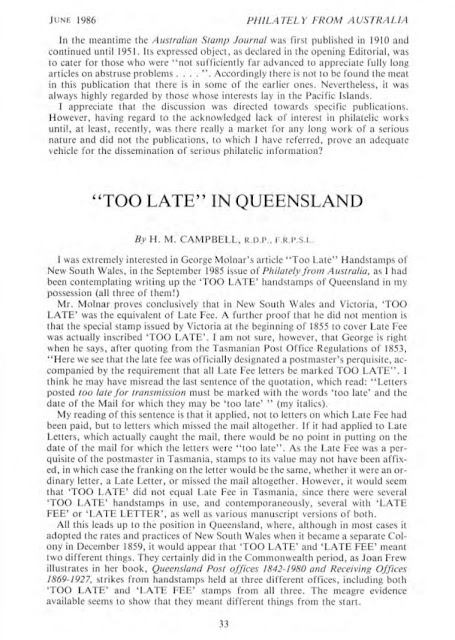
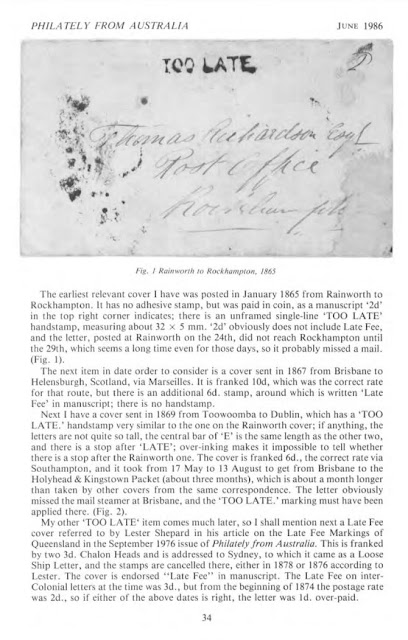
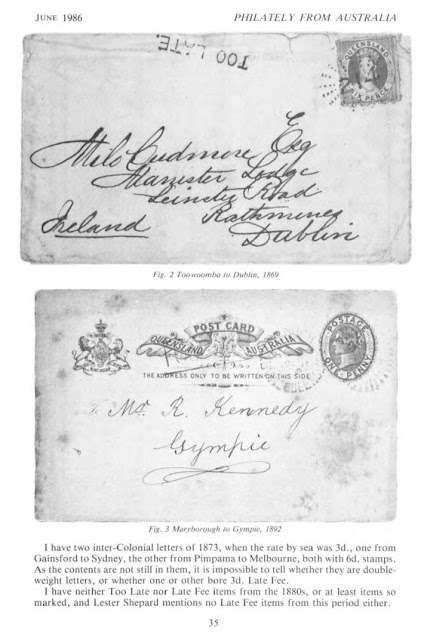
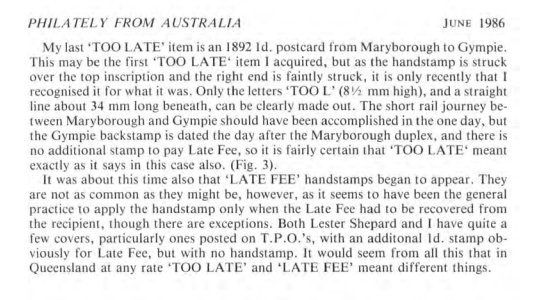
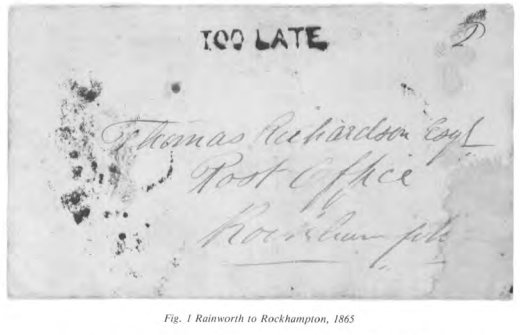
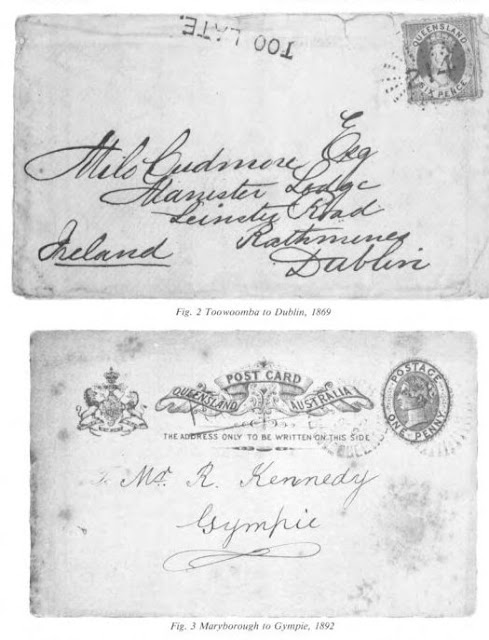
No comments:
Post a Comment